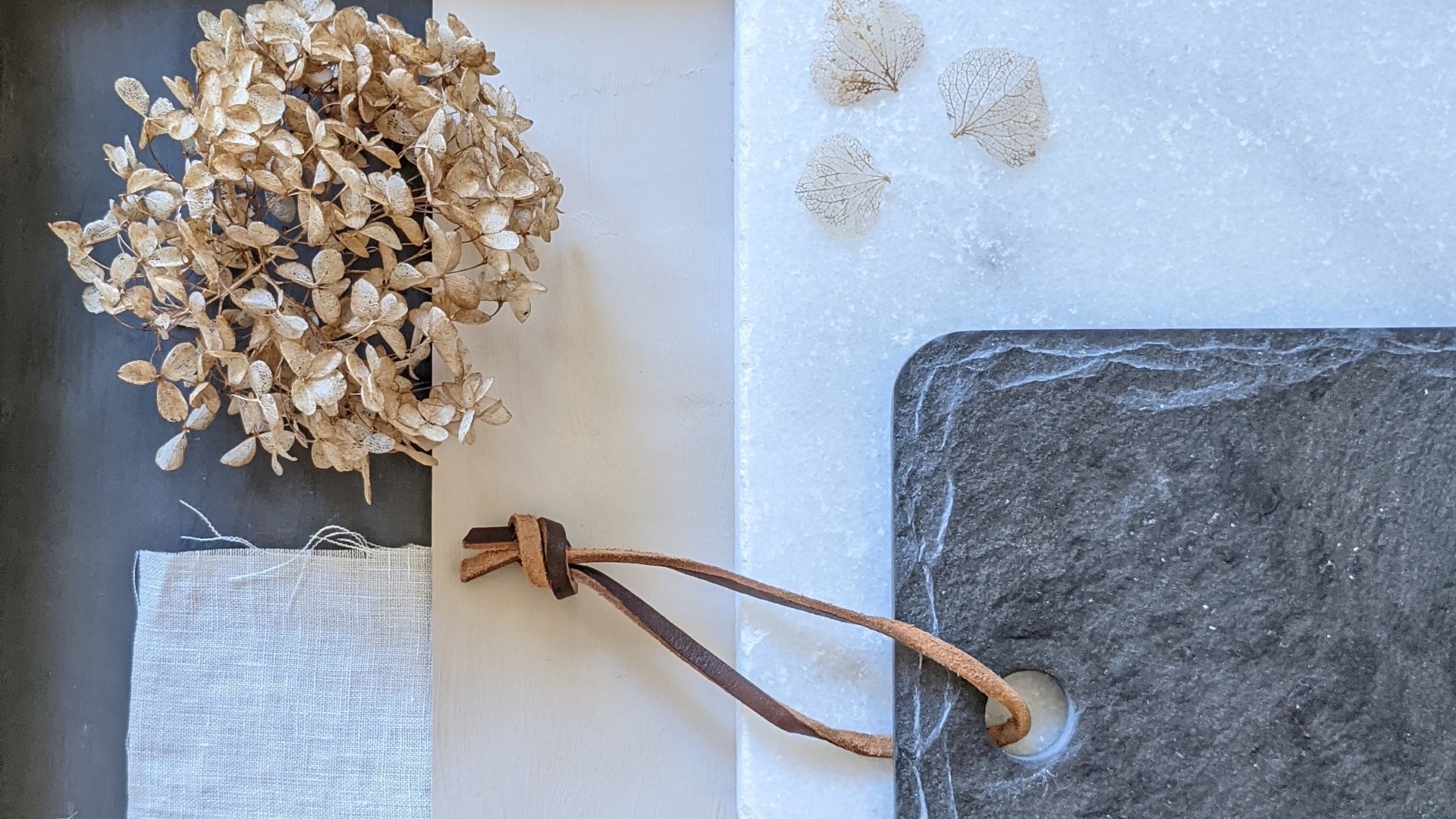I love using natural materials as part of an interior design for wellbeing. Materials such as wood, stone and cork can be better for our health than their synthetic equivalents; they create a general sense of wellbeing, and are often better for the environment. They have a timeless and classic quality that outlasts any passing trend, and they age gracefully, looking all the better for showing the passage of time.
Yes, it’s true that buying natural can cost more up front, but given that wood, stone and metal last and wear so well, you shouldn’t need to buy them more than once. This means that their cost per day of usage is low compared to many cheaper, synthetic products. You can also pick up lots of items second hand, because they still have plenty of wear in them.
Bringing the outside into our homes through natural materials has been linked with all sorts of health benefits that we would normally associate with being in the natural world: for example reduced blood pressure and cortisol levels, improved mood and better concentration.
If you’re looking to create a healthy home which looks and feels good, here is the low-down on the benefits of using natural materials at home, where and how to use them, and how they rate on sustainability.
Linen
LINEN comes from the flax plant and is a bit of a fabric superhero. It’s breathable, hypoallergenic and is moisture-wicking. This means it absorbs dampness but then releases it back into the air, keeping it feeling dry. It gets softer the more it is washed, and looks great even when it’s not ironed.
Use it: In bedlinen, on sofas and chairs, and for curtains and other soft furnishings.
Sustainability: Linen is biodegradable (as long as it is undyed or coloured using biodegradable dyes). When grown in its ideal environment (traditionally northern Europe), it requires no irrigation, pesticides, herbicides or fertilisers. You can find vintage linen at antiques markets.
Cotton
COTTON is also a breathable, hypoallergenic, comfortable fabric which has often been used in home furnishings. It is durable and easy to wash and care for.
Use it: In bedlinen, in rugs, cushions, curtains and other soft furnishings.
Sustainability: Non-organic cotton has been outed as one of the most damaging global crops, because it uses a lot of water and pesticides in its production. If you choose organic cotton products you’re getting all the benefits of this lovely material knowing that it is produced ethically and sustainably. Look for GOTs certification.
Wood
WOOD is probably the widest used and most frequently imitated natural material in our homes. Each wooden item is unique and its pattern, colour and texture is created by the particular environment and species of that tree. It does show wear and tear, but this is part of its charm – I love an old kitchen table with a few dents and scratches in it from regular use.
Use it: It’s always been used a lot for furniture, homewares and flooring, but is increasingly visible on ceilings, walls and worksurfaces.
Sustainability: When new wood comes from a properly managed forest, it is a renewable and environmentally friendly choice. Look for the Forest Stewardship Council (FSC) mark for assurance that the wood has been produced in a responsible way. Or buy second-hand from antiques markets and reclamation yards.
Stone
STONE – such as marble, limestone, slate, sandstone and granite – is strong, versatile and resilient. Like wood, every piece of stone is unique and will contain its own random lines, patterns, colours and textures that are impossible to replicate with synthetic materials. It’s also a great heat conductor that copes really well with being laid over underfloor heating.
Use it: On floors, kitchen and utility worktops, in bathroom tiling, and in fireplace surrounds.
Sustainability: Visit the Ethical Stone Register if you want to be sure that you are buying something sustainably produced. Find out what your local stone is – using this is a great way to connect your home to your local environment and landscape.
Metal
As with wood products, METAL can last a lifetime, and often acquires a beautiful patina or finish as it oxidises over time. Each metal has its own unique properties. For example, COPPER and its alloys (such as brass and bronze) are naturally antimicrobial, meaning that they kill germs on their surface, and ZINC is anti-fungal. Stainless STEEL is strong and doesn’t corrode, while cast IRON is hardwearing and reassuringly solid.
Use it: In places with lots of germ exposure, such as taps, handrails and worksurfaces (copper alloys and zinc). In everyday items such as kitchen utensils and cutlery (stainless steel). In bed frames, stoves and baths (cast iron).
Sustainability: Metals can be recycled over and over again without altering their natural properties. Pick up second-hand items from charity shops, antiques markets and reclamation yards.
Wool
WOOL is a durable, warm and biodegradable fabric (as long as it is not loaded with toxic dyes and chemicals). It’s springy, breathable and insulating, and is naturally flameproof and waterproof. The only downside of wool is that it is very attractive to certain types of moths (which I can personally attest to, having seen them munch their way through my wool carpets in a matter of months!), but moth traps and deterrents are an effective way of preventing any damage.
Use it: In soft furnishings and upholstery, carpets and mattresses.
Sustainability: Choosing organic wool means that the animals it comes from are treated humanely, not given unnecessary antibiotics and pesticides, and that the wool is processed with minimal toxic chemicals.
Jute, coir, seagrass and sisal
These are natural fibres that are frequently used to make flooring. They all create beautiful textures with differing degrees of softness and resilience. JUTE fibre comes from the Cochorus plant, COIR comes from the outer coconut fibres, SEAGRASS grows in coastal meadows, and SISAL is made from agave.
Use it: Flooring and basketware.
Sustainability: All of these fibres are biodegradable and can be produced sustainably.
Bamboo
BAMBOO has become a really popular natural material over the last few years, and there are plenty of good reasons for this. The cane is light-weight and warm in colour, while bamboo yarn makes fabric that is soft, moisture-wicking and breathable.
Use it: Cane is used in furniture, mirrors, flooring, tableware and utensils, while the yarn is used to make rugs, curtains, bedding and soft furnishings.
Sustainability: It’s a fast-growing plant that thrives in many different climates. It grows densely, making it a cost-effective and efficient crop. Very little irrigation is needed, and no pesticides or fertilisers. However, bamboo yarn can use a lot of chemicals in the production process. Some bamboo products are FSC certified.
Cork
CORK, which comes from the bark of the cork oak tree, is set to experience a revival over the coming years because of its special qualities. It is spongy, light-weight, water-repellent, heat-resistant and insulating. It also absorbs sound. Like wood, each piece has its own unique pattern and texture.
Use it: Flooring, placemats, wall and ceiling coverings, and containers.
Sustainability: The cork-stripping process doesn’t harm the tree and doesn’t require it to be cut down – one tree can be harvested many times. Cork can be easily recycled. Cork production is covered by the FSC system of certification.
Leather
LEATHER is a strong, supple material which has been used in furniture production for thousands of years and is a by-product of the meat industry. Each piece of leather is unique, and it wears gently over time, becoming more soft and supple. It is easy to clean, durable and recyclable.
Use it: On chairs, footstools and bedheads, in door handles and drawer pulls, and in wall and floor coverings.
Sustainability: Vegetable tanned leather doesn’t use chrome and other toxic chemicals in the production process so is a much more sustainable alternative to cheap, mass-produced leathers. Look for evidence that leather has been produced from animals that are treated humanely.
When it comes to creating healthy and sustainable homes, the benefits of using natural materials make them an obvious choice. If you’d like to create an interior design for wellbeing, please get in touch.

